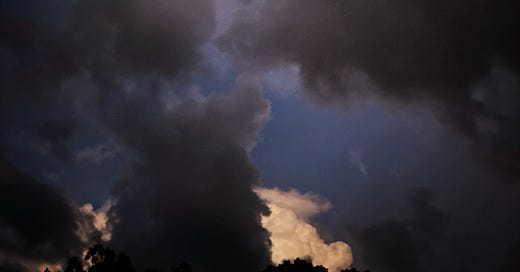I was in high school when I first heeded the call to walk out into the woods and scream. I don’t recall what chapter of teenage angst I was experiencing. I do remember the white January sun above the treetops and my bellows bouncing along the crisp snow out into the ether. I screamed until my voice gave out and then trekked back to school and sat down in class, calm and spent.
Since then, I have screamed from the tops of mountains and the bottoms of ponds. I have yelled while speeding down the interstate and idling at stop signs. I once screamed alongside 2000 women in a dark room at the Javitz Convention Center in Manhattan, an experience that felt at once ancient and newsworthy.
Living in NYC in an apartment building has forced me to get creative about how and when I scream. I wait until everyone leaves the house and then yell into pillows. Sometimes I scream silently in my head, like the Jewish meditation practice of begging and pleading with God called Hitbodedut. For me, screaming is the first turn of the release valve, the gateway for emotions to flow.
During the early days of the pandemic, many of us stepped outside at 7 PM to howl for the front-line workers. It feels like we could use some more collective screaming again.
Screaming and yelling is at the heart of many ancient rituals. Scream therapy got some attention in the west in the 1970s when the provocative psychotherapist Arthur Janov coined the term Primal Therapy to describe the process of fully expressing trapped trauma. One of his more famous clients, artist Yoko Ono went on to create several scream-related works. In Voice Piece for Soprano (1961), she invited viewers to join her in screaming “against the wind/against the wall/against the sky.” In 1975, artist, Marina Abrovnovic staged Freeing the Voice following these simple directions: I lie on the floor with my head tilted backward. I scream until I lose my voice. “When you are screaming without interruption,” she wrote, “at first you recognize your own voice, but later, when you are pushing against your own limits, the voice turns into a sound object.”
Behind a scream, there can lurk a whole slew of emotions: fear, rage, sorrow, joy, and, of course, pleasure. Abrovnovic’s invitation to push past your limits, past any resistance, is, for me, where magic can unfold.
In the past month, many friends have mentioned that they feel like they need to cry but they can’t. If you’re feeling like there are emotions stewing like a swamp waiting for a tide to flush it out, I offer you a practice that I learned from Mama Gena called —appropriately — The Swamp.
The Swamp is an emotional journey that takes you from anger to sadness to pleasure and joy. Surprisingly, you can go through the whole thing in five minutes.
There are two key ingredients for a successful swamp. The first is a good playlist. The second is to really go for it. When rage wants to come through, welcome it by pounding your fists on the couch. I keep a kid’s softball bat around for this purpose and I sometimes slug away at the sofa cushions. Rage almost always gives way to sadness and when that happens, dive in. Fall on the floor like a professional mourner at a funeral. Crawl and wail until you can’t. There doesn’t have to be any particular reason. Being alive is reason enough. How often do you get to investigate these deep emotions in a safe space?
But you don’t want to leave off in that state. I’ve learned from my time with Mama Gena to wrap this practice by coming home to yourself through pleasure. The third song is a slow groove where you can play with all the energy, erotic and otherwise, that shows up when energy starts to move. There is pleasure to be found in this space.
So often we are holding our emotions in because it’s not safe to let them out. This is a practice of creating a safe space to be with any and every emotion.
Try it and let me know in the comments how it goes.
FROM THE INSTITUTE OF PLEASURE STUDIES
Here’s The Pleasure Reports swampy playlist including my favorite song these days, Baby by Ukrainian Folk Quartet DakhaBrakha.
Screaming into the void has a long history. Hitbodedut is a Jewish meditation practice that involves internally screaming into the void all the things that have been unsaid between the speaker and God. Rabbi Nachman describes hitbodedut as “a conversation with God. One can pour out their words before their Creator. One’s conversation with God should be in the everyday language that they normally use.”
I have been reading the War Diary of Yevgenia Belorusets. Winner of the International Literature Prize for her work, she published her personal diary from Kyiv every day at 4 PM.
Want some company while you swamp? Bernadette Pleasant will take you on an emotional journey with live drummers. Her online class is this Sunday
As always, thank you for reading and sharing your feedback with me.




Oh how I needed this today, to know how screaming was primal. I feel like a scream or a cry has been caught in my throat for weeks, and have been thinking a lot of my throat chakra. But this read alone was a kind of sweet release. Thank you.
I like this. Controlled private rage. What a release. I wish I had tried this before slamming the shower door so hard in anger and frustration that it shattered. D'oh